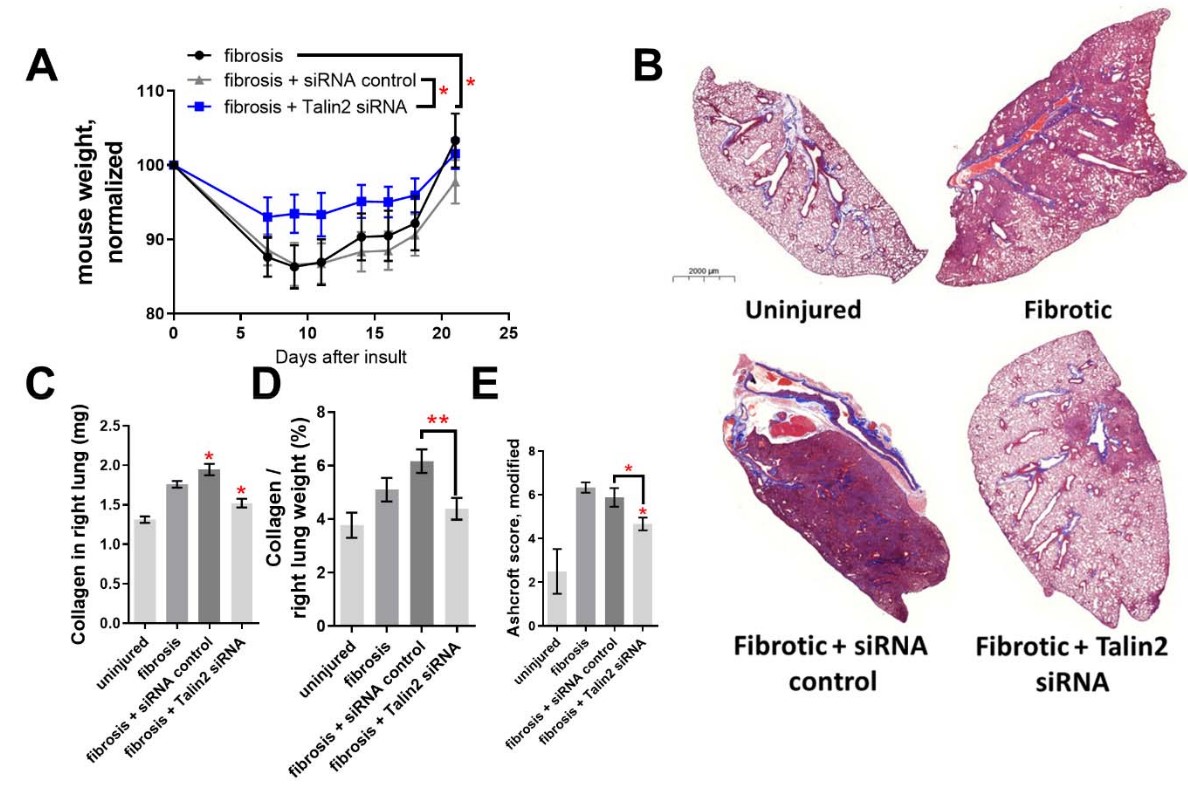SUMMARY
- Fibrosis is involved in 45% of deaths in the United States, and no treatment exists to reverse the progression of the disease. Fibrosing diseases include pulmonary fibrosis, congestive heart failure, liver cirrhosis, and end-stage kidney disease.
- Studies of myofibroblast differentiation have revealed the importance of properties of cell adhesion and how dysregulation of this process can lead to scar tissue formation and fibrosis in the lungs. The inventors found monocytes and fibroblasts cultured on soft surfaces cannot be differentiated into myofibroblasts, which are cells key to scar tissue formation in fibrosis. Talin 2 was identified as a protein involved in the adhesion mechanics in cells specifically in sensing the stiffness of surfaces.
- The invention focuses on novel treatments compositions for fibrotic conditions including the development of a novel anti-fibrotic intracellular target (siRNA Talin2) capable of reversing myofibroblast differentiation in vitro and lung fibrosis in vivo.
FIGURE

Talin2 siRNA rescues the fibrotic damage from bleomycin insult to mouse lungs. 50 μl of 0.2 μM talin2 siRNA was administered to mouse lungs 7, 9, 11, 14, 16, and 18 days after insult by bleomycin. (A) Mouse weights after treatment. (B) Representative images of left, single lobed lungs stained with Massons’s trichrome. (C) Collagen content from the right, multi-lobed lung assessed by hydroxyproline assay. (D) Data from C divided by dry weight of right lobes of mouse lungs. (E) Blinded Ashcroft scoring. n ranges from 6 to 8. * = statistical significance of P < 0.05, < 0.01, or < 0.001, significance vs fibrotic lungs unless otherwise indicated, 2-way ANOVA for panel A, Sidak post-test, Student’s t-test for other panels.
ADVANTAGES
ADVANTAGES
- There are currently two FDA approved treatments (pirfenidone and nintedanib) which slow, but do not reverse, the progression of fibrosis and their MOA has been poorly understood. To date, only one treatment (recombinant pentraxin-2, PRM-151) has shown even a modest ability to reverse fibrosis in some patients.
- This novel anti-fibrotic (silencing RNA against Talin2) is capable of reversing myofibroblast differentiation in vitro and lung fibrosis in vivo.
APPLICATIONS
- This technology has potential applications for treatment in existing fibrosis diseases.
December 27, 2021
Proof of concept
Patent Pending
Licensing,Co-development
Jeffrey Hubbell
- Pre-clinical (In vivo testing)
PUBLICATIONS